Lithogeochemical and Hyperspectral Halos to Ag-Zn-Au Mineralization at Nimbus in the Eastern Goldfields Superterrane, Western Australia
Abstract
1. Introduction
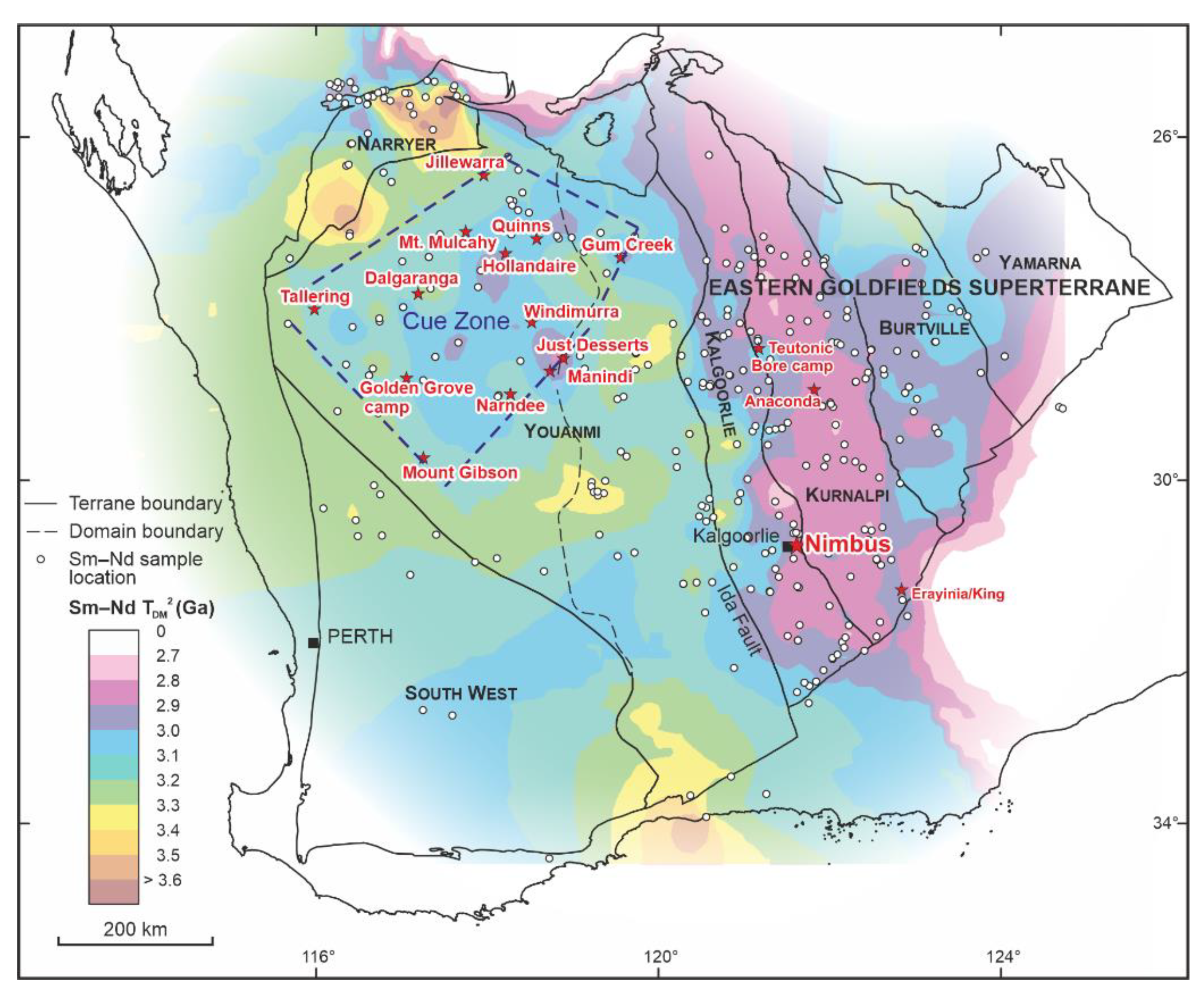
2. Local Geology
3. Previous Research and Methods
3.1. Petrography
3.2. Whole Rock Geochemistry
3.3. Portable XRF Analysis
3.4. Hyperspectral Analysis
4. Mineralization
4.1. Early Pyrite and Sphalerite

4.2. Main Ore Phase
4.3. Stringer Sulfides
4.4. Mafic-Hosted Mineralization
4.5. Late Stage Remobilization
5. Hydrothermal Alteration
6. Geochemistry
6.1. Dacitic Rocks
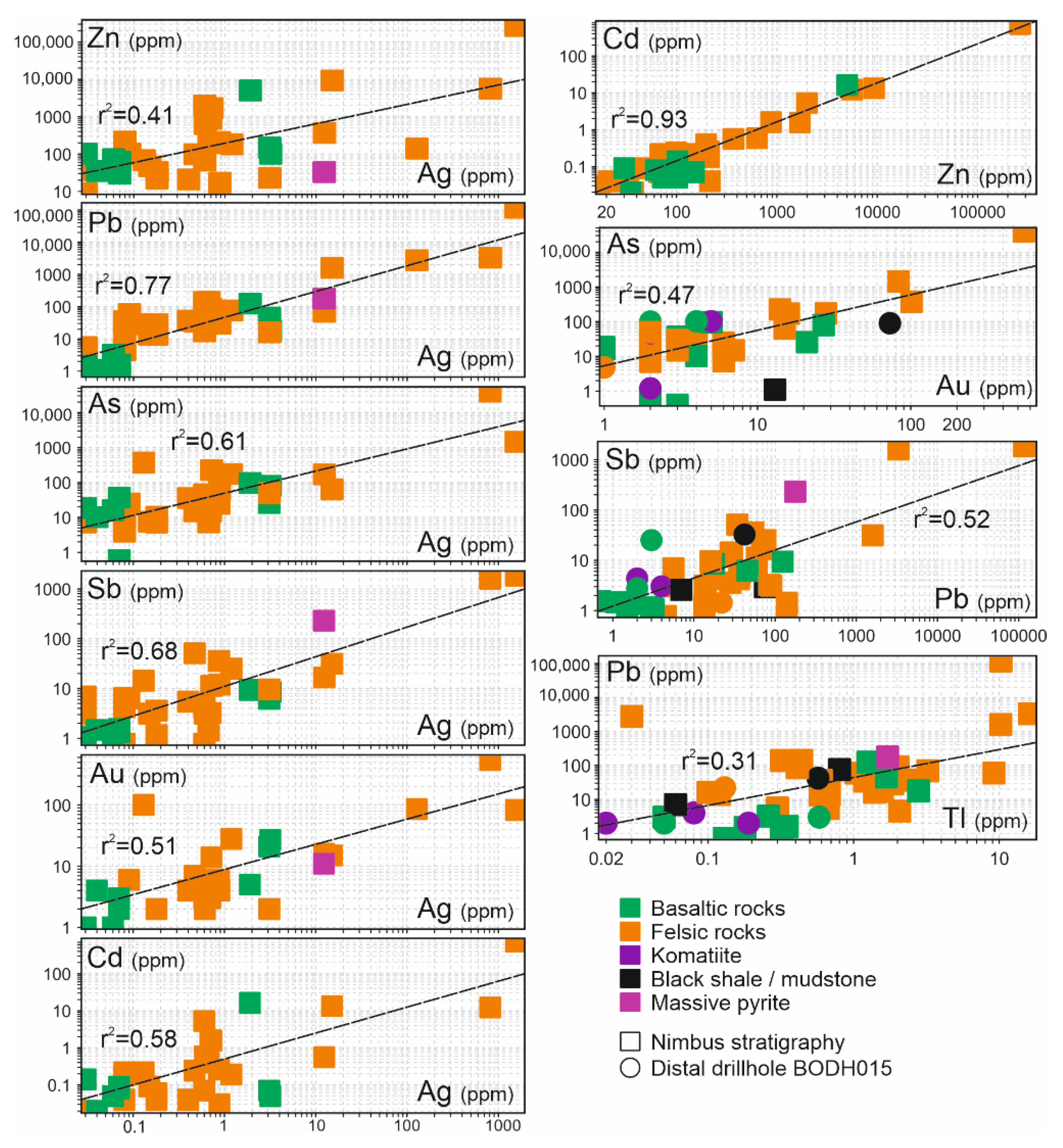
6.2. Mafic Rocks
6.3. Mass Change
7. Hyperspectral Data
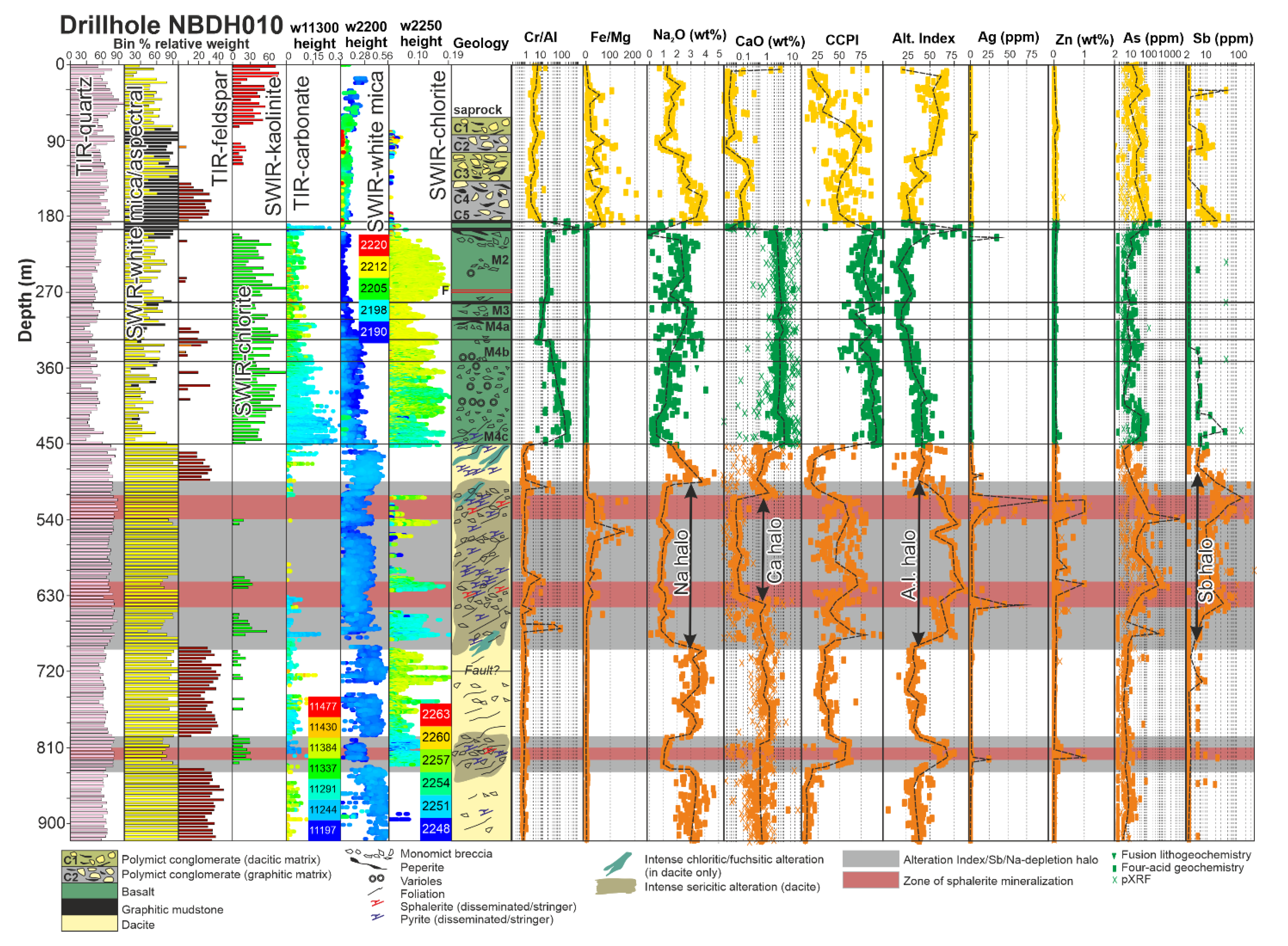
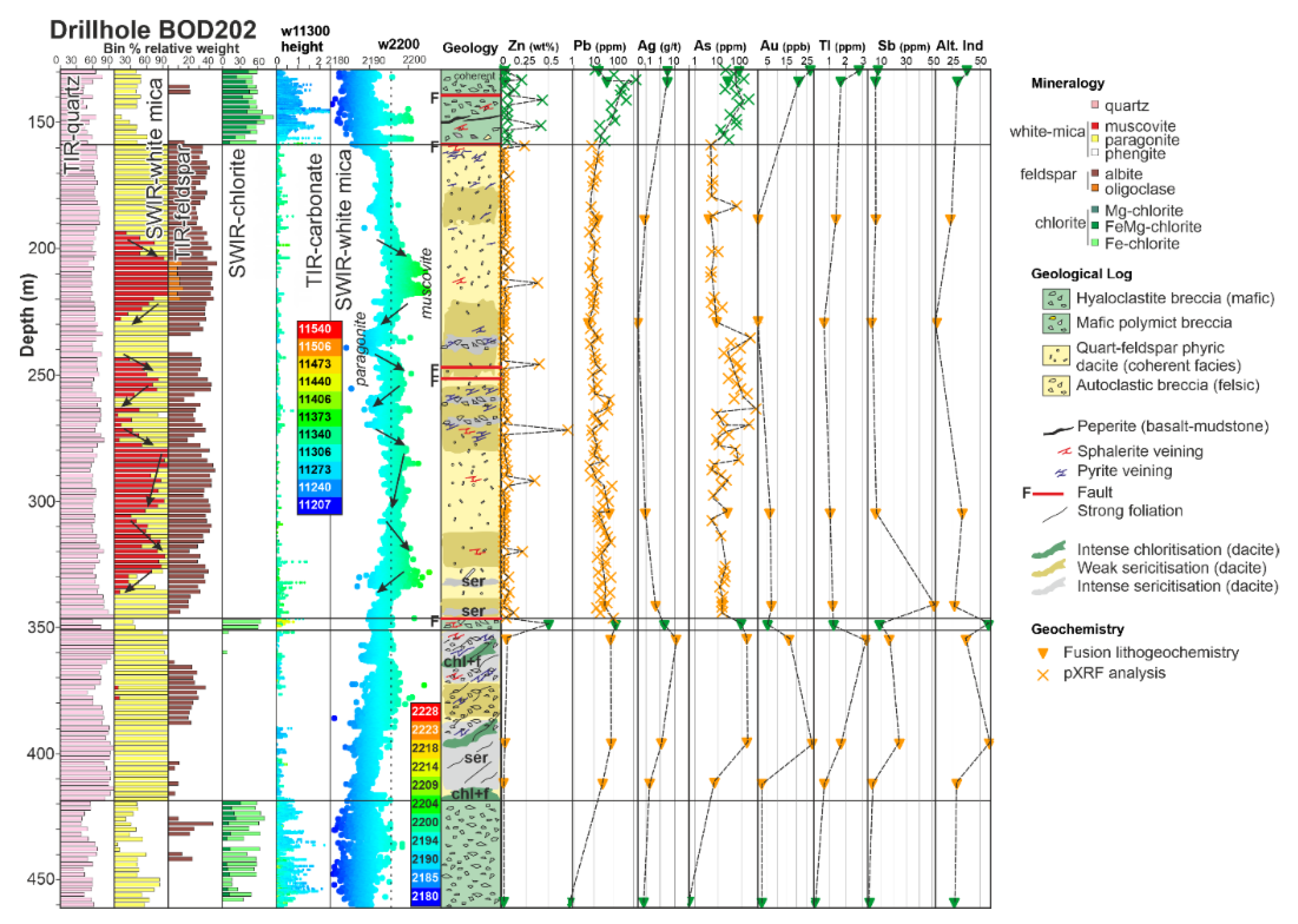
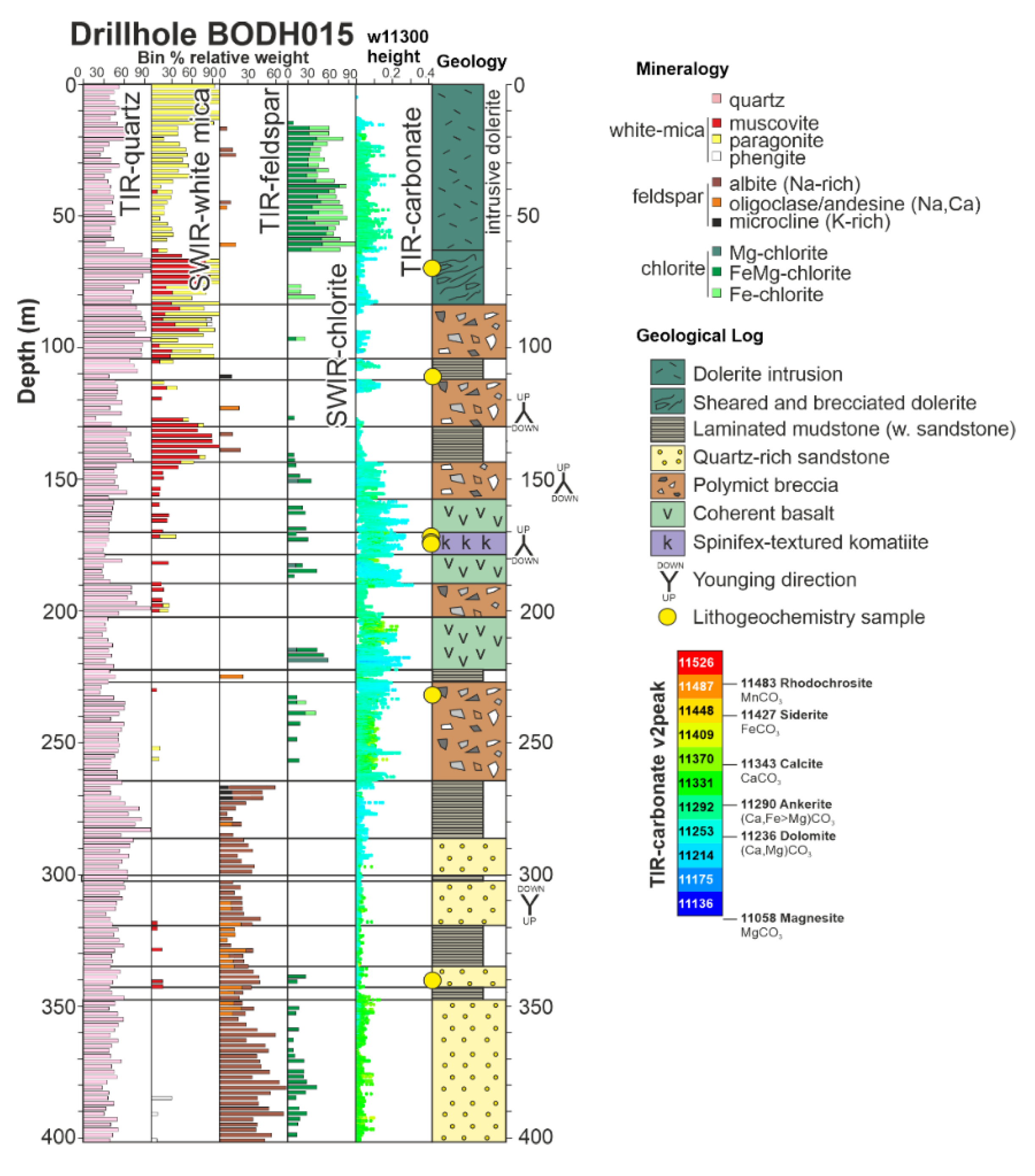
8. Discussion
8.1. Ore Forming Conditions for the Nimbus Deposit
8.2. A Hybrid Bimodal Felsic VMS Deposit
8.3. A Modern Analogue
8.4. Geochemical Halos to Mineralization
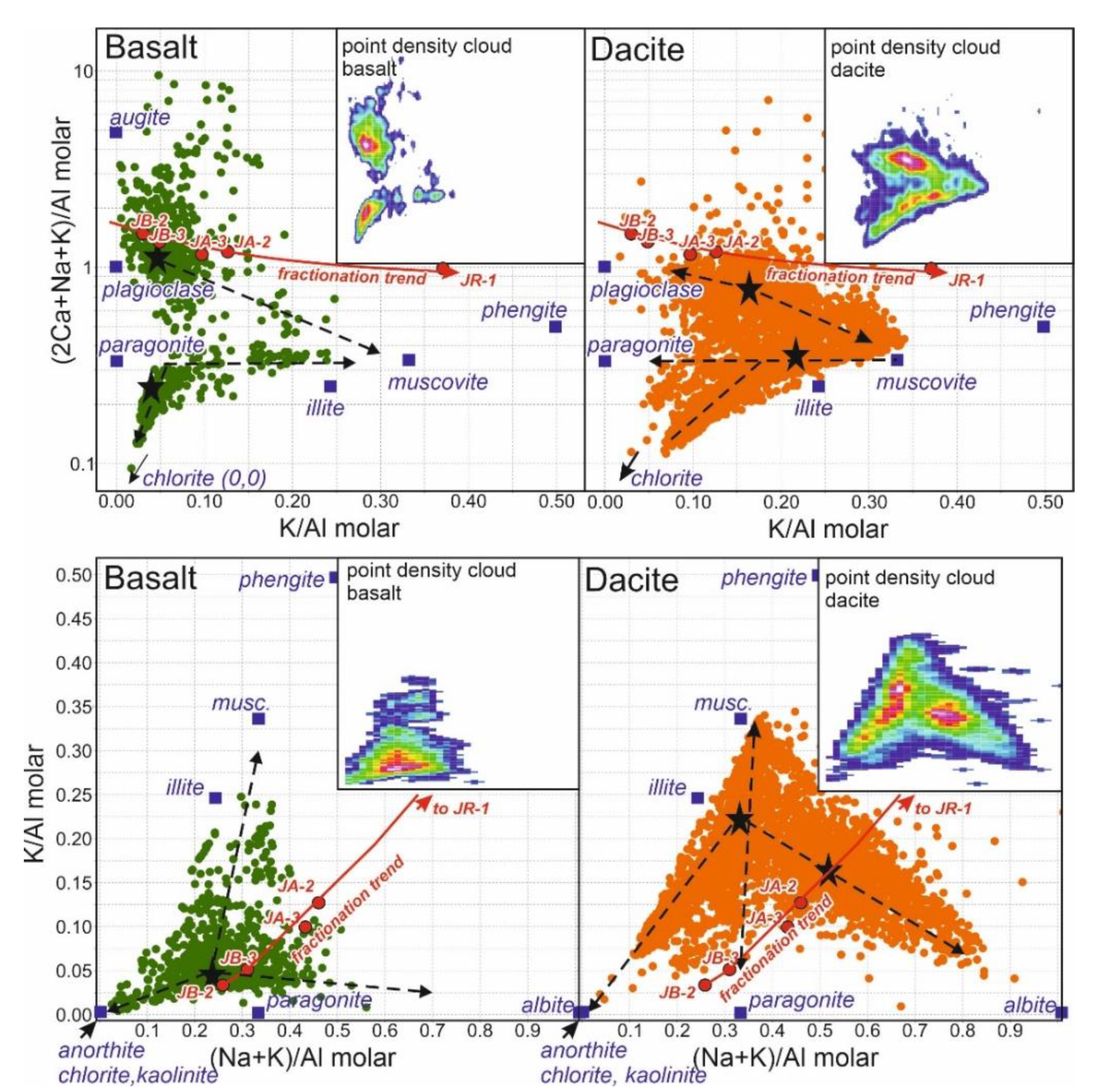
8.5. Hyperspectral Halos to Mineralization
9. Conclusions
- Nimbus exhibits features typical of a hybrid bimodal felsic VMS deposit. It is interpreted as a shallow water (c. 650 mbsl) and low-temperature (<250 °C) VMS deposit, which formed along the margin of the Kurnapi rift zone. A significant magmatic input into the hydrothermal system occurred during the main ore stage.
- Mineralization at Nimbus is characterized by early units of barren massive pyrite that replace glassy dacitic lavas, and underlying zones of polymetallic sulfides that replace autoclastic monomict dacite breccias. The latter are dominated by pyrite-sphalerite-galena, a diverse suite of Ag-Sb ± Pb ± As ± (Cu)-bearing sulfosalts, minor pyrrhotite, arsenopyrite, and rare chalcopyrite. The main sulfosalt suite is characterized by pyrargyrite, and Ag-rich varieties of boulangerite, tetrahedrite, and bournonite.
- Zones of sulfide mineralization are marked by significant mass gains in Fe, S, Zn, Pb, Sb, Ag, As, Cd, Ni, Cu, Ba, Co, Cr, Tl, Bi, and Au (in order of decreasing gains). Basaltic rocks show reduced mass gains in most elements, with zones of intense hydrothermal alteration/mineralization restricted to thick sequences of hyaloclastite, and near contacts with dacitic rocks.
- Broad zones of intense silica-sericite alteration surround mineralization in dacite, marked by high Alteration Index and CCPI values, strong Na-Ca depletion, an absence of feldspar (albite) in thermal infrared (TIR) hyperspectral data, and increases in quartz and white mica contents.
- In dacitic rocks, white mica ranges from muscovitic compositions in weakly altered sections of core and distal positions to mineralization, to increasingly paragonitic compositions that are associated with zones of increased sericitization and sulfide mineralization.
- Chlorite in dacitic rocks often occurs adjacent to zones of sulfide mineralization and is restricted to narrow intervals, possibly linked to higher temperature fluid pathways. Carbonate abundance is sporadic in dacite, but is most abundant outside the main zones of Na-Ca depletion. Towards these halos, carbonate TIR spectra show a shift to lower wavelengths (from Ca-rich to more Mg-rich compositions).
- Basaltic rocks are characterized by strongly paragonitic white mica compositions, and abundant chlorite and carbonate. Shifts from Ca-carbonates and Fe-chlorites to more Mg-rich compositions of both minerals occur in basaltic hyaloclastite and near dacitic contacts.
- Hanging-wall polymict conglomerates are characterized by minor amounts of muscovitic to phengitic white mica, and an absence of chlorite or carbonate alteration.
- The identification of such geochemical and hyperspectral halos elsewhere along the margins of the Kurnalpi rift zone, in either the Kalgoorlie or Burtville terranes, would indicate the position of Nimbus-style mineralization. Similar styles of mineralization might also occur along the margins of the Cue zone in the Youanmi Terrane.
Supplementary Materials
Author Contributions
Funding
Data Availability Statement
Acknowledgments
Conflicts of Interest
References
- Galley, A.; Hannington, M.D.; Jonasson, I.R. Volcanogenic Massive Sulphide Deposits. In Mineral Deposits of Canada: A Synthesis of Major Deposit-Types, District Metallogeny, the Evolution of Geological Provinces, and Exploration Methods; Goodfellow, W.D., Ed.; Special Publication No. 5; Geological Association of Canada, Mineral Deposits Division: St. John’s, NL, Canada, 2007; pp. 141–161. [Google Scholar]
- Buick, R.; Brauhart, C.W.; Morant, P.; Thornett, J.R.; Maniw, J.G.; Archibald, N.J.; Doepel, M.G.; Fletcher, I.R.; Pickard, A.L.; Smith, J.B.; et al. Geochronology and stratigraphic relationships of the Sulphur Springs Group and Strelley Granite: A temporally distinct igneous province in the Archaean Pilbara Craton, Australia. Precambrian Res. 2002, 114, 87–120. [Google Scholar] [CrossRef]
- De Ronde, C.E.J.; Faure, K.; Bray, C.J.; Chappell, D.A.; Wright, I.C. Hydrothermal fluids associated with seafloor mineralization at two southern Kermadec arc volcanoes, offshore New Zealand. Miner. Depos. 2003, 38, 217–233. [Google Scholar] [CrossRef]
- Yeats, C.J.; Hollis, S.P.; Halfpenny, A.; Corona, J.-C.; LaFlamme, C.; Southam, G.; Fiorentini, M.; Herrington, R.J.; Spratt, J. Actively forming Kuroko-type volcanic-hosted massive sulfide (VHMS) mineralization at Iheya North, Okinawa Trough, Japan. Ore Geol. Rev. 2017, 84, 20–41. [Google Scholar] [CrossRef]
- Huston, D.L.; Pehrsson, S.; Eglington, B.M.; Zaw, K. The geology and metallogeny of volcanic-hosted massive sulfide deposits: Variations through geologic time and with tectonic setting. Econ. Geol. 2010, 105, 571–591. [Google Scholar] [CrossRef]
- Huston, D.L.; Champion, D.C.; Cassidy, K.F. Tectonic controls on the endowment of Archean cratons in VHMS deposits: Evidence from Pb and Nd isotopes. In Mineral Deposit Research: Meeting the Global Challenge, Proceedings of the Eighth Biennial SGA Meeting, Beijing, China, 18–21 August 2005; Mao, J., Bierlein, F.P., Eds.; Springer: Cham, Switzerland, 2005; pp. 15–18. [Google Scholar]
- Huston, D.L.; Champion, D.C.; Cassidy, K.F. Tectonic controls on the endowment of Neoarchean cratons in volcanic-hosted massive sulfide deposits: Evidence from lead and neodymium isotopes. Econ. Geol. 2014, 109, 11–26. [Google Scholar] [CrossRef]
- Hollis, S.P.; Yeats, C.J.; Wyche, S.; Barnes, S.J.; Ivanic, T.J.; Belford, S.M.; Davidson, G.J.; Roache, A.J.; Wingate, M.T.D. A review of volcanic-hosted massive sulfide (VHMS) mineralization in the Archaean Yilgarn Craton, Western Australia: Tectonic, stratigraphic and geochemical associations. Precambrian Res. 2015, 260, 113–135. [Google Scholar] [CrossRef]
- Doyle, M. Evaluation of Genetic Links between Mineralisation, Alteration and Volcanism at Nimbus Prospect, Western Australia; Unpublished Report; UNITAS Consulting, University of Tasmania: Hobart, Australia, November 1998. [Google Scholar]
- Belford, S.M. The Nimbus Deposit: Notes and Thoughts on What can be Determined from the Diamond Drillcore Regarding the Setting and Geological Model; Unpublished Report; MacPhersons Reward Gold Ltd.: Kalgoorlie, Australia, June 2011. [Google Scholar]
- Henderson, I.; Goodz, M.; Vearncombe, J. Nimbus: Fault-hosted Ag-Zn-Pb-Au Mineralisation near Kalgoorlie, Western Australia. AIG Struct. Geol. Resour. 2012, 89–92. [Google Scholar]
- Hildrew, C.L. Understanding the Nature of Host Rock Succession to the Archaean Nimbus Ag-Zn-Pb-Au Deposit, WA. Unpublished Master’s Thesis, School of Physical Sciences, University of Tasmania, Hobart, Australia, 2015. [Google Scholar]
- Hollis, S.P.; Mole, D.R.; Gillespie, P.; Barnes, S.J.; Tessalina, S.; Cas, R.A.F.; Hildrew, C.; Pumphrey, A.; Goodz, M.D.; Caruso, S.; et al. 2.7 Ga plume associated VHMS mineralization in the Eastern Goldfields Superterrane, Yilgarn Craton: Insights from the low temperature and shallow water, Ag-Zn-(Au) Nimbus deposit. Precambrian Res. 2017, 291, 119–142. [Google Scholar] [CrossRef]
- Caruso, S.; Fiorentini, M.L.; Hollis, S.P.; LaFlamme, C.; Baumgartner, R.J.; Steadman, J.A.; Savard, D. The fluid evolution of the Nimbus Ag-Zn-(Au) deposit: An interplay between mantle plume and microbial activity. Precambrian Res. 2018, 317, 211–229. [Google Scholar] [CrossRef]
- Barrote, V.; Tessalina, S.; McNaughton, N.; Jourdan, F.; Hollis, S.P.; Ware, B.; Zi, J.-W. 4D history of the Nimbus VHMS ore deposit in the Yilgarn Craton, Western Australia. Precambrian Res. 2020, 337, 105536. [Google Scholar] [CrossRef]
- Barrote, V.; Tessalina, S.; McNaughton, N.; Evans, N.J.; Hollis, S.P.; McDonald, B.J. Surge of ore metals in seawater and increased bioactivity: A tracer of VHMS mineralisation in sedimentary Archaean successions, Yilgarn Craton, Western Australia. Miner. Depos. 2020, 1–22. [Google Scholar] [CrossRef]
- Hollis, S.P.; Podmore, D.; James, M.; Menuge, J.F.; Doran, A.D.; Yeats, C.J.; Wyche, S. VHMS mineralisation at Erayinia in the Eastern Goldfields Superterrane: Geology and geochemistry of the metamorphosed King Zn deposit. Aust. J. Earth Sci. 2019, 66, 153–181. [Google Scholar] [CrossRef]
- Duuring, P.; Hassan, L.; Zelic, M.; Gessner, K. Geochemical and spectral footprint of metamorphosed and deformed VMS-style mineralization in the Quinns district, Yilgarn Craton, Western Australia. Econ. Geol. 2016, 111, 1411–1438. [Google Scholar] [CrossRef]
- Trofimovs, J.; Davis, B.K.; Cas, R.A.F.; Barley, M.E.; Tripp, G.I. Reconstructing the event stratigraphy from the complex structural—Stratigraphic architecture of an Archaean volcanic—Intrusive—Sedimentary succession: The Boorara Domain, Eastern Goldfields Superterrane, Western Australia. Aust. J. Earth Sci. 2006, 53, 303–327. [Google Scholar] [CrossRef]
- Rosengren, N.M.; Cas, R.A.F.; Beresford, S.W.; Palich, B.M. Reconstruction of an extensive Archaean dacitic submarine volcanic complex associated with the komatiite hosted Mt Keith nickel deposit, Agnew-Wiluna Greenstone belt, Yilgarn Craton, Western Australia. Precambrian Res. 2008, 161, 34–52. [Google Scholar] [CrossRef]
- Cas, R.A.F.; Marks, K.; Perazzo, S.; Beresford, S.; Trofimovs, J.; Rosengren, N. Were intercalated komatiites and dacites at the Black Swan nickel sulfide mine, Yilgarn Craton, Western Australia emplaced as lavas or sills? The significance of breccia textures and contact relationships. Precambrian Res. 2013, 229, 133–149. [Google Scholar] [CrossRef]
- Barnes, S.J.; Van Kranendonk, M.J. Archean andesites in the East Yilgarn Craton, Australia: Products of plume/crust interaction? Lithos 2014, 6, 80–92. [Google Scholar] [CrossRef]
- Townend, R. File 25.04.10; Unpublished Report; Archaean Gold NL: Kalgoorlie, Australia, 1996. [Google Scholar]
- Powell, P. Nimbus Scoping Study: An Examination of a Silver Oxide Project; Unpublished report; 1999; pp. 1–149. [Google Scholar]
- Marjoribanks, R. Nimbus silver zinc mineralisation, Western Australia—Observations, interpretations and comments. In A Report Prepared for MacPhersons Resources Limited; MacPhersons Report No 1; MacPhersons Resources Limited: Kalgoorlie, Australia, 11 July 2012; pp. 1–30. [Google Scholar]
- McArthur, G.J. Nimbus sulphide composite test work mineralogy. In Report for MacPhersons Reward Gold Ltd.; MacPhersons Reward Gold Ltd.: Kalgoorlie, Australia, September 2006. [Google Scholar]
- Crawford, A.J. Petrographic Report. 17 Rocks from the Nimbus Project, Western Australia; Unpublished Report; MacPhersons Resources Ltd.: Kalgoorlie, Australia, 17 April 2012; pp. 1–93. [Google Scholar]
- Mulholland, I.R.; Hay, I.P.; Ion, J.C.; Greenaway, A.L.; Cowden, A. Nimbus Silver-Zinc Deposit. In Geology of Australian and Papua New Guinean Mineral Deposits Monograph 22; Berkman, D.A., Mackenzie, D.H., Eds.; The Australian Institute of Mining and Metallurgy: Carlton, VI, Australia, 1998; pp. 273–278. [Google Scholar]
- Le Vaillant, M.; Barnes, S.J.; Fiorentini, M.L.; Miller, J.; McCuaig, T.C.; Muccilli, P. A hydrothermal Ni-As-PGE geochemical halo around the Miitel komatiite-hosted Ni sulfide deposit, Yilgarn Craton, Western Australia. Econ. Geol. 2015, 110, 505–530. [Google Scholar] [CrossRef]
- Jenner, G.A. Trace Element Geochemistry of Igneous Rocks: Geochemical Nomenclature and Analytical Geochemistry. In Trace Element Geochemistry of Volcanic Rocks: Applications for Massive Sulfide Exploration Short Course Notes 12; Wyman, D.A., Ed.; Geological Association of Canada: St. John’s, NL, Canada, 1996; pp. 51–77. [Google Scholar]
- Piercey, S.P.; Devine, M.C. Analysis of powdered reference materials and samples by portable X-ray fluorescence spectrometer: Performance and application to lithogeochemistry. Geochem. Explor. Environ. Anal. 2014, 14, 139–148. [Google Scholar] [CrossRef]
- Hancock, E.A.; Green, A.A.; Huntington, J.F.; Schodlok, M.C.; Whitbourne, L.B. Hylogger-3: Implications of Adding Thermal-infrared Sensing. In Geological Survey of Western Australia; Record 2013/3; Government of Western Australia: Perth, WA, Australia, 2013. [Google Scholar]
- McLeod, R.L.; Gabell, A.R.; Green, A.A.; Gadavski, V. Chlorite infrared spectral data as proximity indicators of volcanogenic massive sulphide mineralization. In Proceedings of the Pacific Rim Congress 87, Gold Coast, QLD, Australia, 26 August 1987; pp. 321–324. [Google Scholar]
- Herrmann, W.; Blake, M.; Doyle, M.; Huston, D.; Kamprad, J.; Merry, N.; Pontual, S. Short wavelength infrared (SWIR) spectral analysis of hydrothermal alteration zones associated with base metal sulfide deposits at Rosebery and Western Tharsis, Tasmania, and Highway-Reward, Queensland. Econ. Geol. 2001, 96, 939–955. [Google Scholar] [CrossRef]
- Guilliamse, J.N. Assessing the Potential for Volcanic-Hosted Massive Sulfide Mineralization at Weld Range, Using Golden Grove for Comparison. In Geological Survey of Western Australia; Report 141; Government of Western Australia: Perth, WA, Australia, 2014; pp. 1–61. [Google Scholar]
- Laakso, K.; Peter, J.M.; Rivard, B.; White, H.P. Short-wave infrared spectral and geochemical characteristics of hydrothermal alteration at the Archean Izok Lake Zn-Cu-Pb-Ag volcanogenic massive sulfide deposit, Nunavut, Canada: Applications in exploration target vectoring. Econ. Geol. 2016, 111, 1223–1239. [Google Scholar] [CrossRef]
- Green, D.; Schodlok, M. Characterisation of carbonate minerals from hyperspectral TIR scanning using features at 14 000 and 11 300 nm. Aust. J. Earth Sci. 2016, 63, 951–957. [Google Scholar] [CrossRef]
- MacPhersons Resources. Nimbus Increases Resources. ASX–Nimbus JORC Resource Update. Available online: www.macphersonsresources.com.au (accessed on 30 April 2015).
- Deditius, A.P.; Reich, M.; Kesler, S.E.; Utsunomiya, S.; Chryssoulis, S.L.; Walshe, J.; Ewing, R.C. The coupled geochemistry of Au and as in pyrite from hydrothermal ore deposits. Geochim. Cosmochim. Acta 2014, 140, 644–670. [Google Scholar] [CrossRef]
- MacLean, W.H. Mass change calculations in altered rock series. Miner. Depos. 1990, 25, 44–49. [Google Scholar] [CrossRef]
- Large, R.R.; Gemmell, J.B.; Paulick, H. The Alteration Box Plot: A simple approach to understanding the relationship between alteration mineralogy and lithogeochemistry associated with volcanic-hosted massive sulfide deposits. Econ. Geol. 2001, 96, 957–971. [Google Scholar] [CrossRef]
- Grant, J.A. The Isocon diagram—A simple solution to Gresens Equation for metasomatic alteration. Econ. Geol. 1986, 81, 1976–1982. [Google Scholar] [CrossRef]
- Grant, J.A. Isocon analysis: A brief review of the method and applications. Phys. Chem. Earth 2005, 30, 997–1004. [Google Scholar] [CrossRef]
- Petersen, S.; Monecke, T.; Westhues, A.; Hannington, M.D.; Gemmell, J.B.; Sharpe, R.; Peters, M.; Strauss, H.; Lackschewitz, K.; Augustin, N.; et al. Drilling shallow-water massive sulfides at the Palinuro Volcanic Complex, Aeolian Island Arc, Italy. Econ. Geol. 2014, 109, 2129–2157. [Google Scholar] [CrossRef]
- Barrett, T.J.; Sherlock, R.L. Geology, lithogeochemistry and volcanic setting of the Eskay Creek Au-Ag-Cu-Zn deposit, northwestern British Columbia. Explor. Min. Geol. 1996, 5, 339–368. [Google Scholar]
- Sherlock, R.L.; Roth, T.; Spooner, E.T.C.; Bray, C.J. Origin of the Eskay Creek precious metal-rich volcanogenic massive sulfide deposit: Fluid inclusion and stable isotope evidence. Econ. Geol. 1999, 94, 803–824. [Google Scholar] [CrossRef]
- Amcoff, Ö. Distribution of silver in massive sulfide ores. Miner. Depos. 1984, 19, 63–69. [Google Scholar] [CrossRef]
- Huston, D.L.; Sie, S.H.; Suter, G.F.; Cooke, D.R.; Both, R.A. Trace elements in sulfide minerals from eastern Australian volcanic-hosted massive sulfide deposits: Part I, proton microprobe analyses of pyrite, chalcopyrite and sphalerite, and part II, selenium levels in pyrite; comparison with delta 34S values and implications for the source of sulfur in volcanogenic hydrothermal systems. Econ. Geol. 1995, 90, 1167–1196. [Google Scholar]
- Huston, D.L.; Jablonski, W.; Sie, S.H. The distribution and mineral hosts of silver in eastern volcanogenic massive sulfide deposits. Can. Mineral. 1996, 34, 529–546. [Google Scholar]
- Cook, N.J.; Ciobanu, C.L.; Pring, A.; Skinner, W.; Shimizu, M.; Danyushevsky, L.; Saini-Eidukat, B.; Melcher, F. Trace and minor elements in sphalerite: A LA-ICPMS study. Geochim. Cosmochim. Acta 2009, 73, 4761–4791. [Google Scholar] [CrossRef]
- McArthur, G.J. Nimbus sulfide composite testwork mineralogy. Unpublished report. September 2006. [Google Scholar]
- McArthur, G.J. Nimbus prospect mineral residence of silver. Unpublished report. December 2012. [Google Scholar]
- Brueckner, S.M.; Piercey, S.J.; Pilote, J.-L.; Layne, G.D.; Sylvester, P.J. Mineralogy and mineral chemistry of the metamorphosed and precious metal-bearing Ming deposit, Canada. Ore Geol. Rev. 2016, 72, 914–939. [Google Scholar] [CrossRef]
- Delaney, J.R.; Cosens, B.A. Boiling and metal deposition in submarine hydrothermal systems. Mar. Technol. Soc. J. 1982, 16, 62–66. [Google Scholar]
- Hannington, M.D.; Poulsen, K.H.; Thompson, J.F.H.; Sillitoe, R.H. Volcanogenic Gold in the Massive Sulfide Environment. In Volcanic-Associated Massive Sulfide Deposits: Processes and Examples in Modern and Ancient Settings; Barrie, C.T., Hannington, M.D., Eds.; Society of Economic Geologists: Littleton, CO, USA, 1999; Volume 8, pp. 325–356. [Google Scholar]
- Bischoff, J.L.; Rosenbauer, R.J. The critical point and two-phase boundary of seawater, 200–500 °C. Earth Planet. Sci. Lett. 1984, 68, 172–180. [Google Scholar] [CrossRef]
- Monecke, T.; Petersen, S.; Hannington, M.D. Constraints on water depth of massive sulfide formation: Evidence from modern seafloor hydrothermal systems in arc-related settings. Econ. Geol. 2014, 109, 2079–2101. [Google Scholar] [CrossRef]
- Sillitoe, R.H.; Hannington, M.D.; Thompson, J.F.H. High sulfidation deposits in the volcanogenic massive sulfide environment. Econ. Geol. 1996, 91, 204–212. [Google Scholar] [CrossRef]
- Piercey, S.J. The setting, style, and role of magmatism in the formation of volcanogenic massive sulphide deposits. Miner. Depos. 2011, 46, 449–471. [Google Scholar] [CrossRef]
- Piercey, S.J.; Hinchey, J. Volcanogenic massive sulphide (VMS) deposits of the Central Mineral Belt, Newfoundland. In Geological Association of Canada–Mineralogical Association of Canada Joint Annual Meeting, Field Trip Guidebook; Newfoundland and Labrador Department of Natural Resources, Geological Survey: St. John’s, NL, Canada, 2012; Volume 4, pp. 1–56. [Google Scholar]
- Mercier-Langevin, P.; Hannington, M.D.; Dubé, B.; Bécu, V. The gold content of volcanogenic massive sulfide deposits. Miner. Depos. 2011, 46, 509–539. [Google Scholar] [CrossRef]
- Roth, T.; Thompson, J.F.H.; Barrett, T.J. The precious metal-rich Eskay Creek deposit, northwestern British Columbia. In Volcanic-Associated Massive Sulfide Deposits: Processes and Examples in Modern and Ancient Settings; Barrie, C.T., Hannington, M.D., Eds.; Society of Economic Geologists: Littleton, CO, USA, 1999; Volume 8, pp. 357–373. [Google Scholar]
- Hinchey, J.G. The Tulks Volcanic Belt, Victoria Lake Supergroup, Central Newfoundland-Geology, Tectonic Setting, and Volcanogenic Massive Sulfide Mineralization Report 2011–02; Newfoundland and Labrador Department of Natural Resources, Geological Survey: St. John’s, NL, Canada, 2011; pp. 1–167. [Google Scholar]
- Large, R.R. The Significance of Hybrid Deposits in the Continuum of VHMS-Epithermal and Porphyry Systems: An Example from the Mt Read Volcanics. In Volcanic Environments and Massive Sulfide Deposits, Program and Abstracts; Gemmel, J.B., Pontgratz, J., Eds.; CODES Special Publication: Hobart, Australia, 2000; Volume 3, pp. 1–113. [Google Scholar]
- Corbett, K.D. New mapping and interpretations of the Mount Lyell mining district, Tasmania: A large hybrid Cu-Au system with an exhalative Pb-Zn top. Econ. Geol. 2001, 96, 1089–1122. [Google Scholar] [CrossRef]
- Huston, D.L.; Kamprad, J. Zonation of alteration facies at Western Tharsis: Implications for the genesis of Cu-Au deposits, Mount Lyell field, Western Tasmania. Econ. Geol. 2001, 96, 1123–1132. [Google Scholar] [CrossRef]
- Steefel, C.J. The Johnson River prospect, Alaska: Gold-rich sea- floor mineralization from the Jurassic. Econ. Geol. 1987, 82, 894–914. [Google Scholar] [CrossRef]
- Bussey, S.D.; LeAnderson, P.J. Geology of the iron dyke mine and surrounding permian hunsaker creek formation. In Geology of the Blue Mountains Region of Oregon, Idaho and Washington: Stratigraphy, Physiography, and Mineral Resources of the Blue Mountains Region; Vallier, T.R., Brooks, H.C., Eds.; Professional Paper 1439; US Geological Survey: Reston, VA, USA, 1994; pp. 151–181. [Google Scholar]
- Williams, N.C.; Davidson, G.J. Possible submarine advanced argillic alteration at the Basin Lake prospect, Western Tasmania, Australia. Econ. Geol. 2004, 99, 987–1002. [Google Scholar] [CrossRef]
- Sillitoe, R.H.; Hedenquist, J.W. Linkages Between Volcanotectonic Settings, Ore-Fluid Compositions, and Epithermal Precious Metal Deposits. In Volcanic, Geothermal and Ore-Forming Fluids: Rulers and Witnesses of Processes Within the Earth; Simmons, S.F., Graham, I., Eds.; Special Publication 10; Society of Economic Geologists: Littleton, CO, USA, 2005; pp. 315–343. [Google Scholar]
- Gibson, H.L.; Morton, R.L.; Hudak, G.J. Submarine Volcanic Processes, Deposits and Environments Favourable for the Location of Volcanic-Associated Massive Sulfide Deposits. In Volcanic-Associated Massive Sulfide Deposits: Processes and Examples in Modern and Ancient Settings; Barrie, C.T., Hannington, M.D., Eds.; Society of Economic Geologists: Littleton, CO, USA, 1999; Volume 8, pp. 13–51. [Google Scholar]
- Barrote, V.; McNaughton, N.; Tessalina, S.; Evans, N.J.; Talavera, C.; Zi, J.-W.; McDonald, B.J. The 4D evolution of the Teutonic Bore Camp VHMS deposits, Yilgarn Craton, Western Australia. Ore Geol. Rev. 2020, 120, 103448. [Google Scholar] [CrossRef]
- Tufar, W. Paragenesis of complex massive sulfide ores from the Tyrrhenian Sea. Mitt. Osterr. Geol. Ges. 1991, 84, 265–300. [Google Scholar]
- Petersen, S.; Monecke, T.; Augustin, N.; De Benedetti, A.A.; Esposito, A.; Gärtner, A.; Gardeler, A.; Gemmell, J.B.; Gibson, H.; He, G.; et al. Drilling submarine hydrothermal systems in the Tyrrhenian Sea, Italy. InterRidge News 2008, 17, 21–23. [Google Scholar]
- Monecke, T.; Petersen, S.; Lackschewitz, K.; Hügler, M.; Hannington, M.D.; Gemmell, J.B. Shallow submarine hydrothermal systems in the Aeolian volcanic arc, Italy. EOS Trans. Union 2009, 90, 110–111. [Google Scholar] [CrossRef]
- Thiel, V.; Hügler, M.; Blümel, M.; Baumann, H.I.; Gärtner, A.; Schmaljohann, R.; Strauss, H.; Garbe-Schönberg, D.; Petersen, S.; Cowart, D.A.; et al. Widespread occurrence of two carbon fixation pathways in tubeworm endosymbionts: Lessons from hydrothermal vent associated tubeworms from the Mediterranean Sea. Front. Microbiol. 2012, 3, 423. [Google Scholar] [CrossRef]
- Peter, J.M.; Scott, S.D. Windy Craggy, Northwestern British Columbia: The World’s Largest Besshi-Type Deposit. In Volcanic-Associated Massive Sulfide Deposits: Processes and Examples in Modern and Ancient Settings; Barrie, C.T., Hannington, M.D., Eds.; Society of Economic Geologists: Littleton, CO, USA, 1999; Volume 8, pp. 261–295. [Google Scholar]
- Pirajno, F.; Chen, Y.; Li, N.; Li, C.; Zhou, L. Besshi-type mineral systems in the Palaeoproterozoic Bryah rift-basin, Capricorn orogeny, Western Australia: Implications for tectonic setting and geodynamic evolution. Geosci. Front. 2016, 7, 345–357. [Google Scholar] [CrossRef][Green Version]
- Peltonen, P.; Kontinen, A.; Huhma, H.; Kuronen, U. Outokumpu revisited: New mineral deposit model for the mantle peridotite-associated Cu-Co-Zn-Ni-Ag-Au sulphide deposits. Ore Geol. Rev. 2008, 33, 559–617. [Google Scholar] [CrossRef]
- Crerar, D.; Wood, S.; Brantley, S.; Bocarsly, A. Chemical controls on the solubility of ore-forming minerals in hydrothermal solutions. Can. Mineral. 1985, 23, 333–352. [Google Scholar]
- Jones, S.; Herrmann, W.; Gemmell, J.B. Short wavelength infrared spectral characteristics of the HW horizon: Implications for exploration in the Myra Falls volcanic-hosted massive sulfide camp, Vancouver Island, British Columbia, Canada. Econ. Geol. 2005, 100, 273–294. [Google Scholar] [CrossRef]
- Hinchey, J.G. Visible/infrared spectroscopy (VIRS) of volcanogenic massive sulphide hydrothermal alteration products, Tulks Volcanic Belt, central Newfoundland: An additional exploration technique? In Current Research: Newfoundland and Labrador Department of Natural Resources, Geological Survey; Report 11-1; Newfoundland and Labrador Department of Natural Resources, Geological Survey: St. John’s, NL, Canada, 2011; pp. 97–108. [Google Scholar]
- Piercey, S.J. Lithogeochemistry of Volcanic Rocks Associated with Volcanogenic Massive Sulphide Deposits and Applications to Exploration. In Submarine Volcanism and Mineralization: Modern Through Ancient; Cousens, B., Piercey, S.J., Eds.; Geological Association of Canada: St. John’s, NL, Canada, 2009; pp. 15–40. [Google Scholar]
- Hollis, S.P.; Podmore, D.; James, M.; Mole, D.; Turner, O.; Kneeshaw, A.; Beaton, R. Targeting VHMS mineralization at Erayinia in the Eastern Goldfields Superterrane using lithogeochemistry, soil chemistry and Hylogger data. J. Geochem. Explor. 2019, 207, 106379. [Google Scholar] [CrossRef]
- Dehnavi, A.S.; McFarlane, C.R.M.; Lentz, D.R.; McClenaghan, S.H.; Walker, J.A. Chlorite-white mica pairs’ composition as a microchemical guide to fingerprint massive sulfide deposits of the Bathurst Mining Camp, Canada. Minerals 2019, 9, 125. [Google Scholar] [CrossRef]
- Hassan, L.Y. Alteration Associated with the Austin-Quinns VMS Prospects, Northern Yilgarn Craton. In Geological Survey of Western Australia; Record 2017/10; Geological Survey: St. John’s, NL, Canada, 2017; pp. 1–61. [Google Scholar]
- Hassan, L.Y. The Yuinmery Volcanogenic Massive Sulfide Prospects: Mineralization, Metasomatism and Geology. In Geological Survey of Western Australia; Report 131; Geological Survey: St. John’s, NL, Canada, 2014; pp. 1–65. [Google Scholar]
- Hassan, L.Y. Metamorphosed VMS Mineralization at Wheatley, Southwest Western Australia. In Geological Survey of Western Australia; Record 2017/9; Geological Survey: St. John’s, NL, Canada, 2017; pp. 1–39. [Google Scholar]
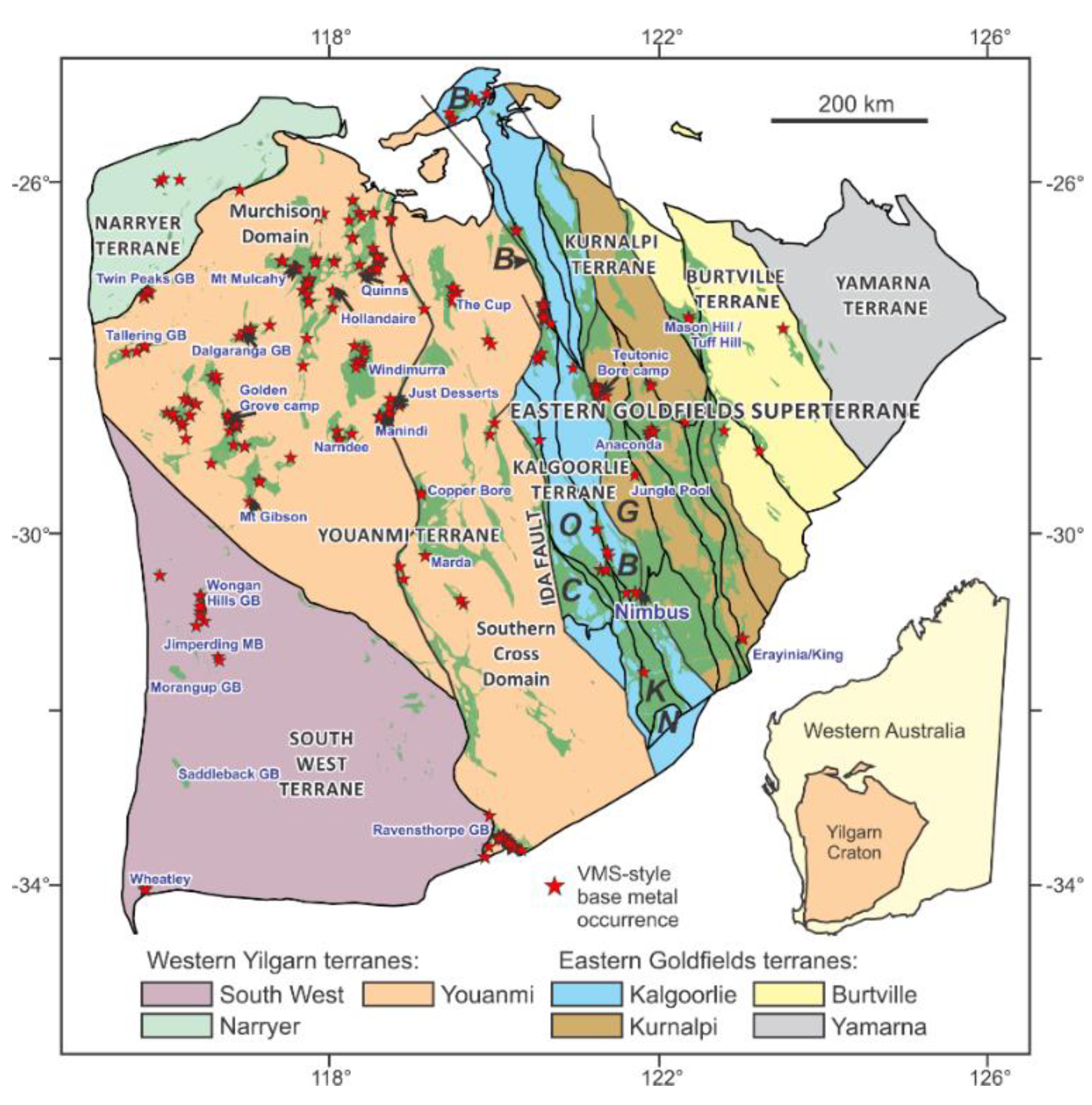
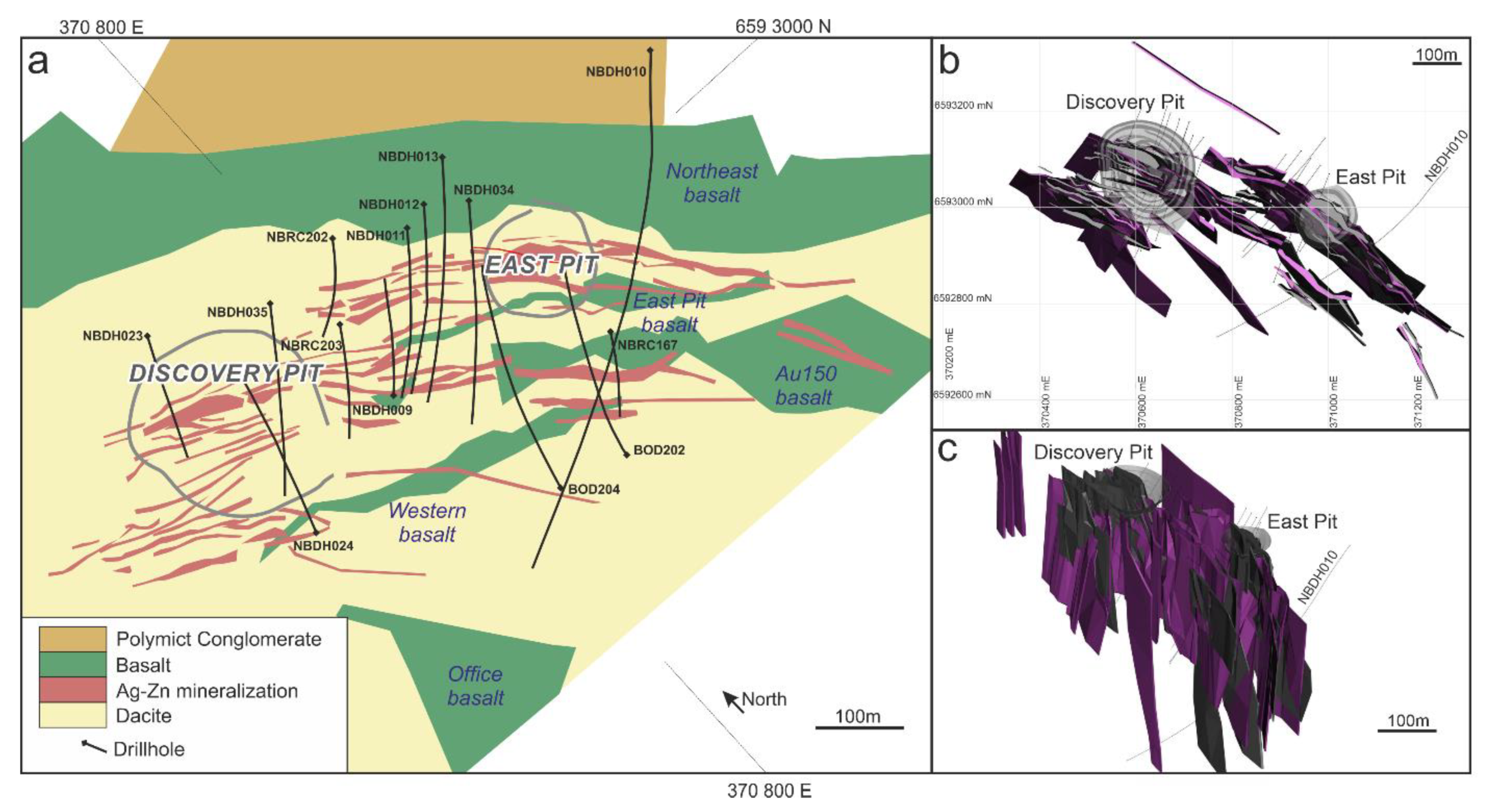
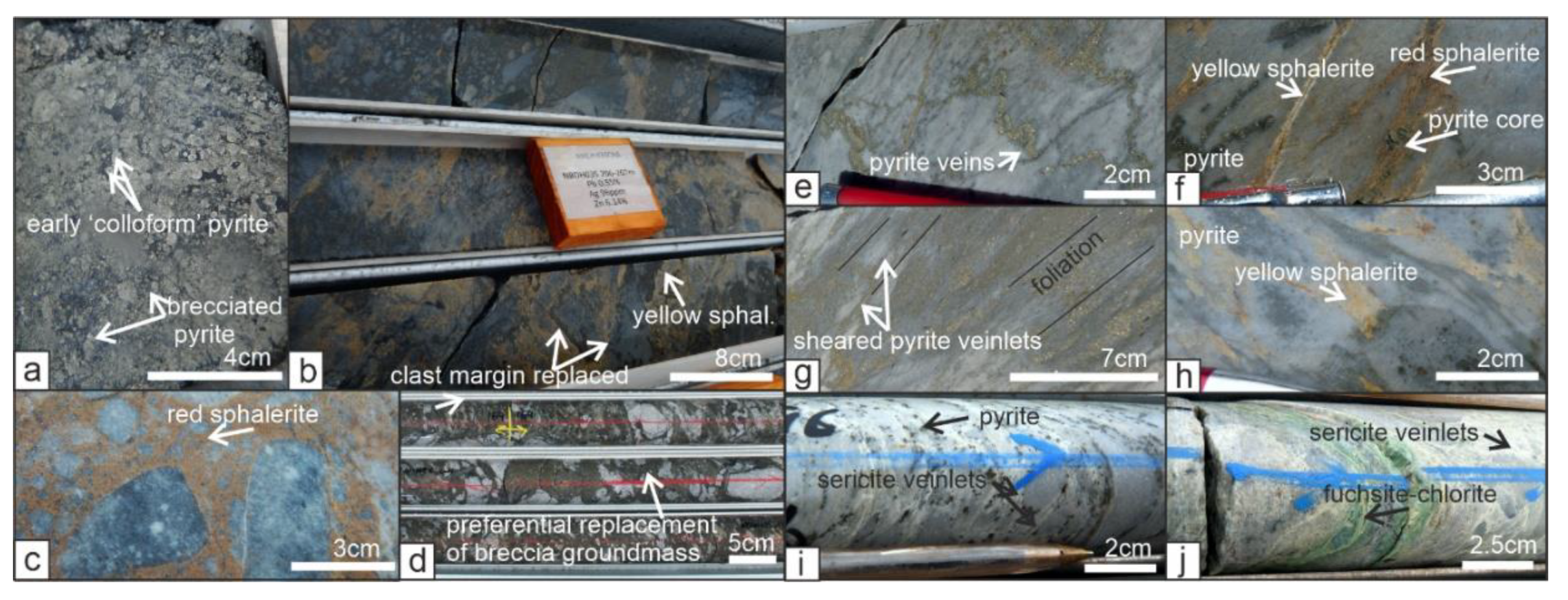
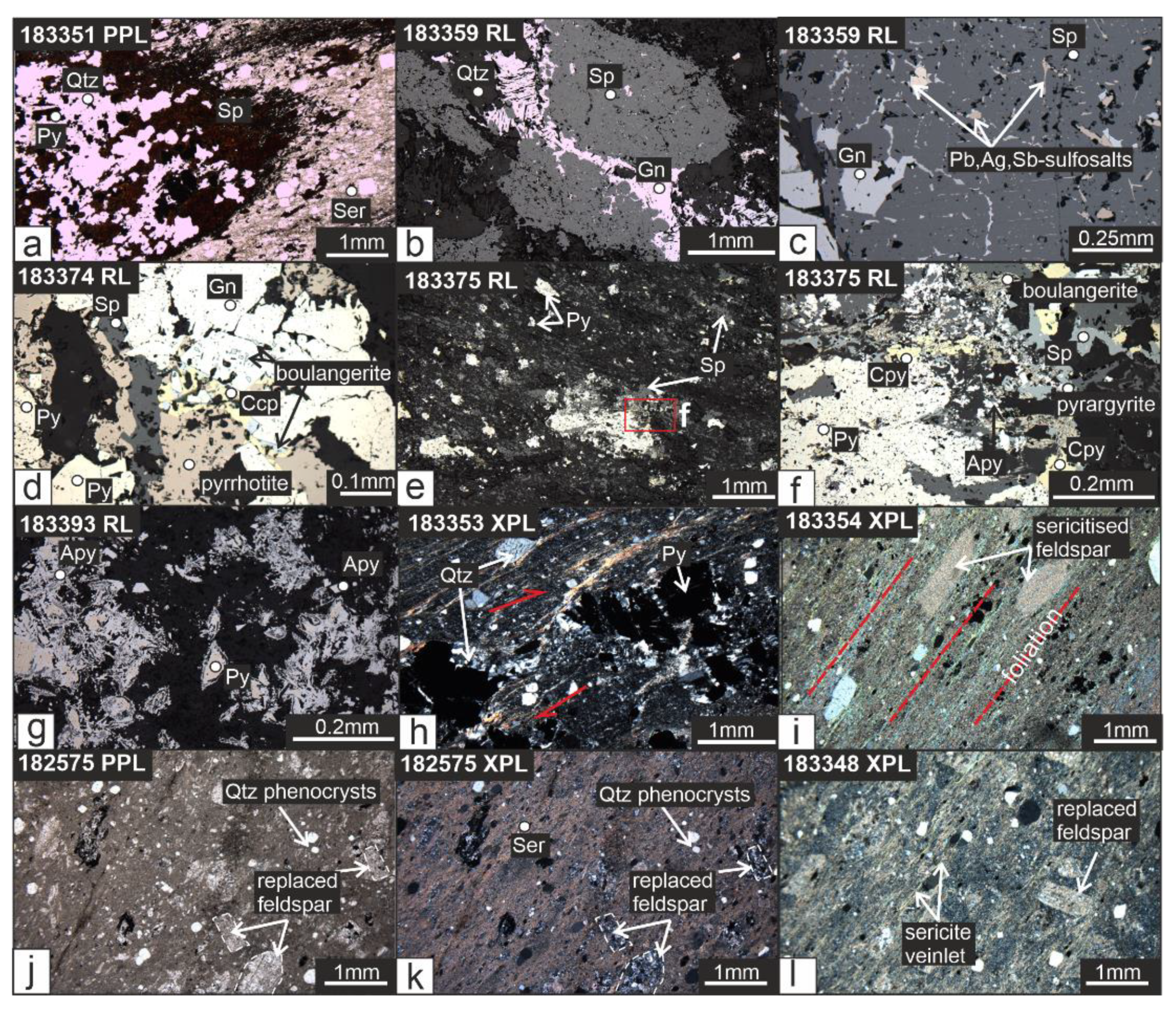

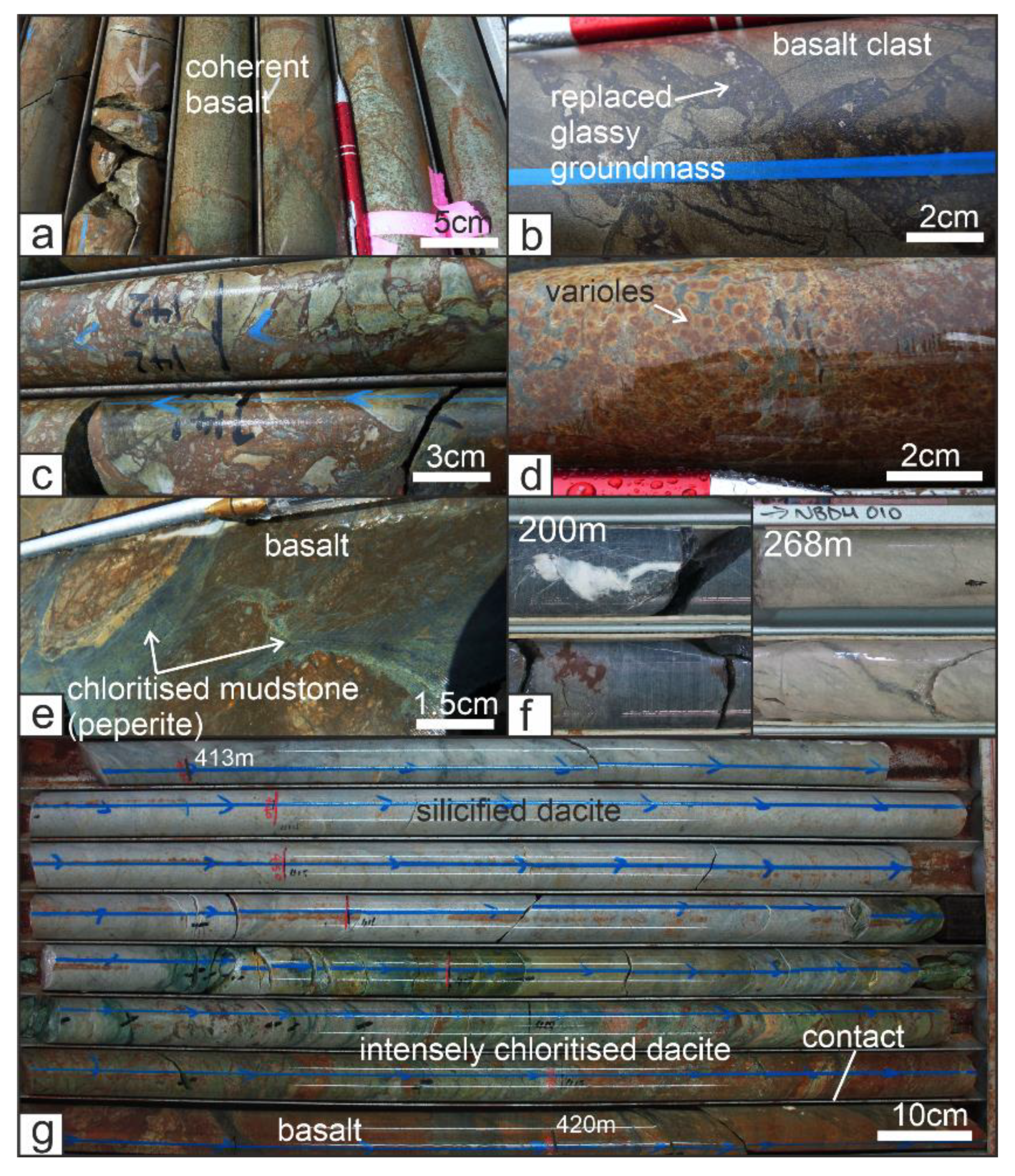
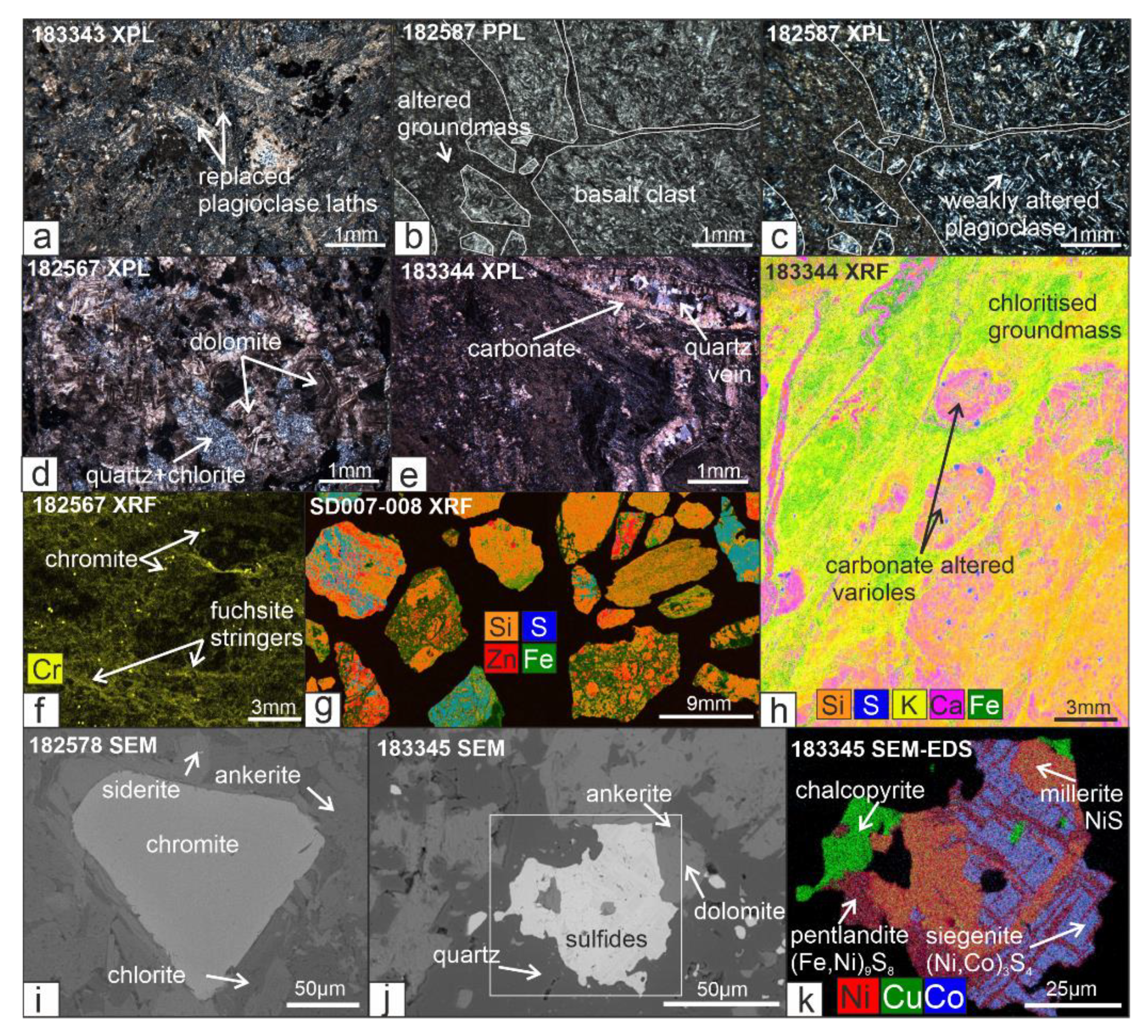

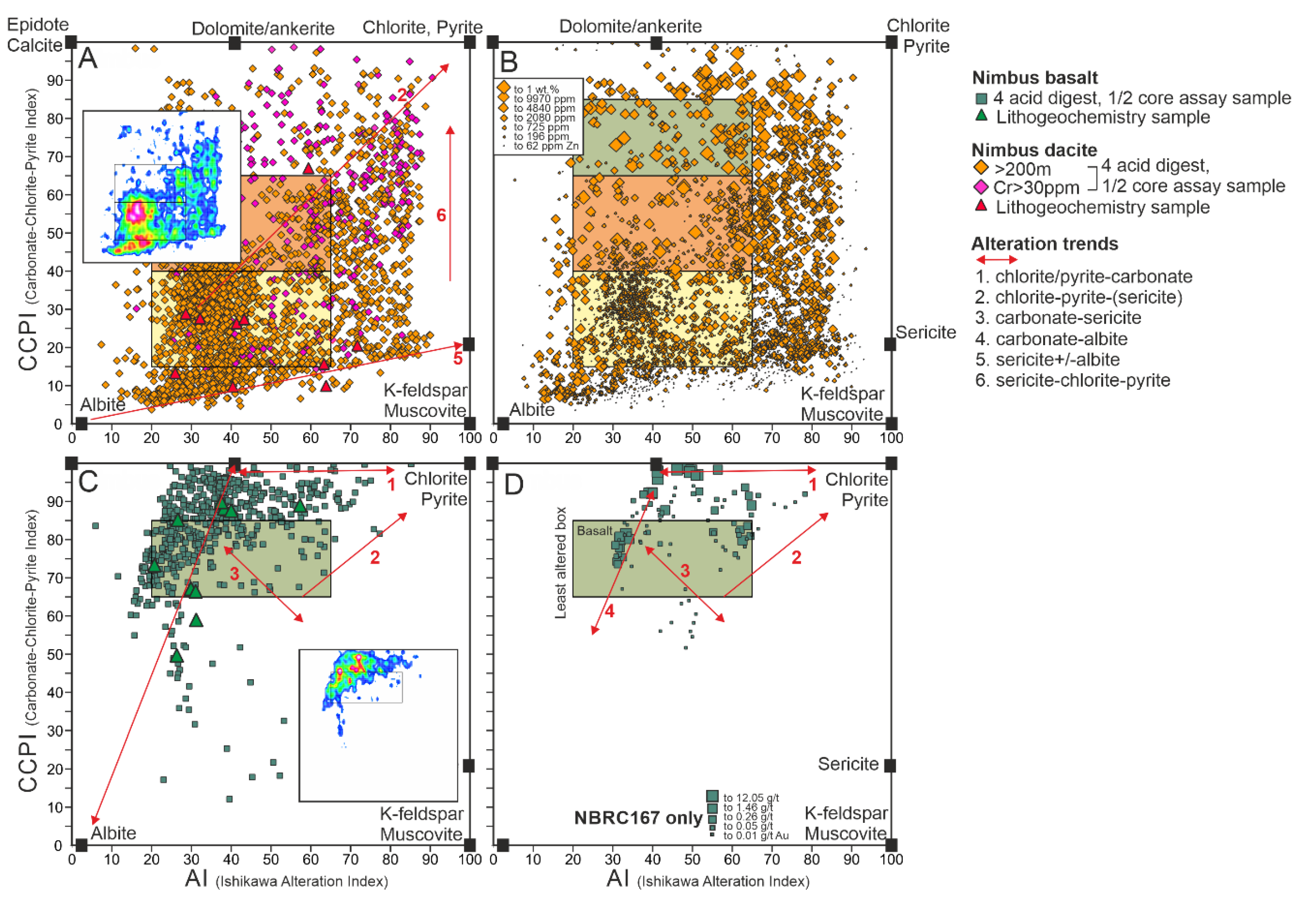
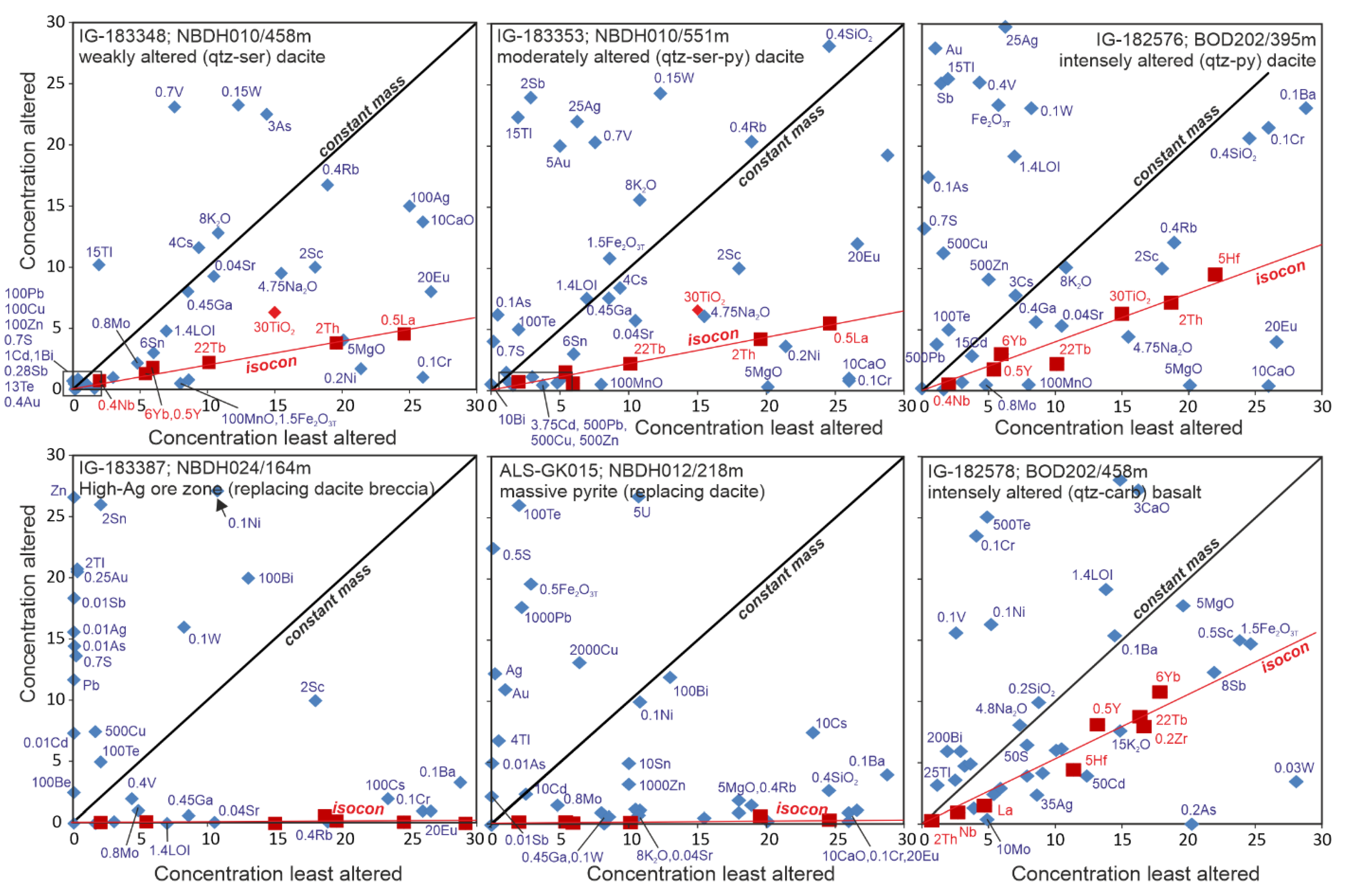
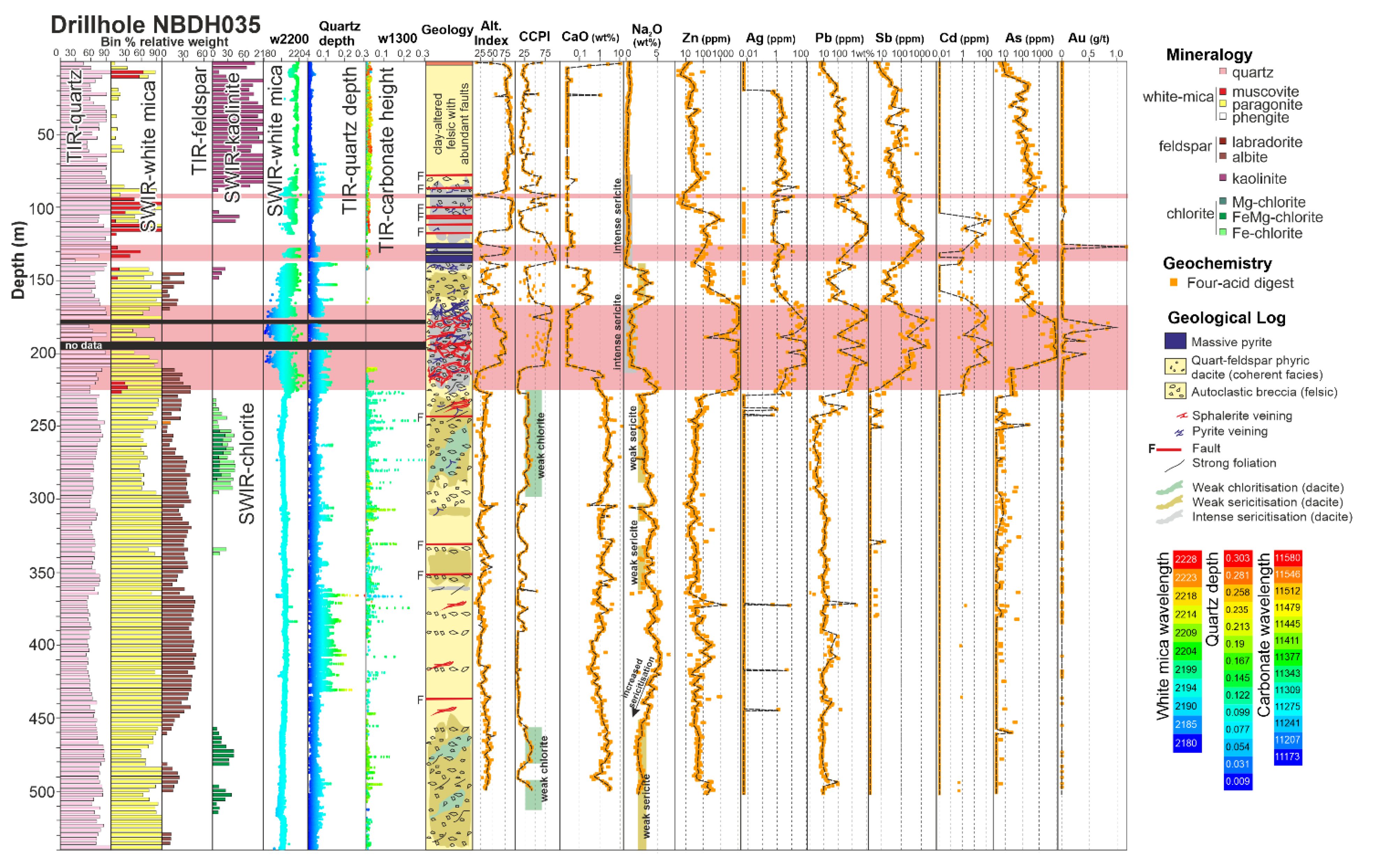
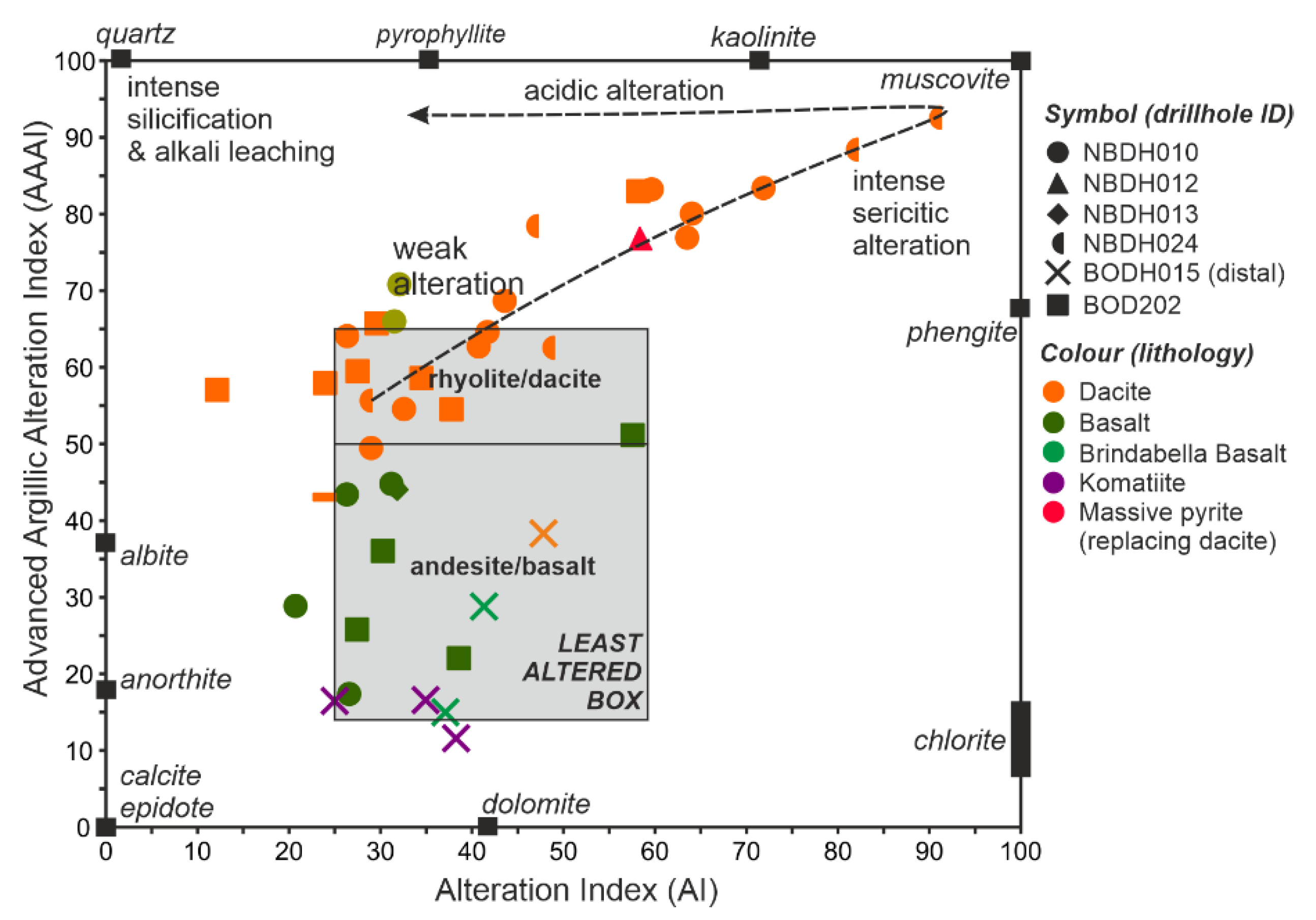
| Mineral Phase | Ideal Mineral Formula | Trace Element Concentration (for Elements with Mean Concentrations >0.1wt.%) |
|---|---|---|
| Pyrite (main ore stage) | FeS2 | Varies upon type (e.g., As) |
| Sphalerite | (FeZn)S | Cd ~0.1 |
| Galena | PbS | Fe 0.21, Cd 0.12 |
| Chalcopyrite | CuFeS2 | None. |
| Arsenopyrite | FeAsS | Zoned in Co, Ni, Sb. |
| Pyrrhotite | Fe(1-x)S | Ni 0.27 |
| Boulangerite | Pb5Sb4S11 | As 0.17, Bi 0.14, Zn 0.14 |
| Ag-rich Boulangerite | (Pb,Ag)5Sb4S11 | As 0.22, Zn 0.12 |
| Pyrargyrite | Ag3SbS3 | * |
| Ag-rich Tetrahedrite | (Cu,Fe,Zn,Ag)12Sb4S13 | As 0.36, Fe 5.68, Zn 2.21, Ag 14.25, Cd 0.1, Bi 0.21, Hg 0.42 |
| Ag-rich Bournonite | (Pb,Ag)CuSbS3 | Fe 4.66, Pb 1.46, Zn 3.34, Cd 0.24, 0.16, Hg 0.51. |
| Marrite | AgPbAsS3 | * |
| Freibergite | (Ag,Cu,Fe)12(As,Sb)4S13 | * |
| Owyheeite | Pb7Ag2(Sb,Bi)8S20 | * |
| Pyrostilpnite | Ag3SbS3 | Pb 2.16, Cd 0.34, Bi 0.27, Hg 0.22 |
| Covellite | CuS | * |
| Enargite | Cu3AsS4 | * |
| Pentlandite | (Fe,Ni)9S8 | * |
| Jalpaite | (Ag,Cu)2S | * |
| Meneghinite | Pb13CuSb7S24 | Bi 0.35, 0.64 Cu |
| Millerite | NiS | * |
| Siegenite | (Ni,Co)3S4 | * |
| Ullmannite | NiSbS | Fe 6.88, Cu 4.68, Pb 0.52, Zn 1.66, Ag 10.2, Hg 0.18 |
| Fe-rich Viaeneite | (Fe,Pb)4S8O | Sb 4.79, Pb 3.8, Ni 2.76 |
| Cassiterite | Sn2O | * |
Publisher’s Note: MDPI stays neutral with regard to jurisdictional claims in published maps and institutional affiliations. |
© 2021 by the authors. Licensee MDPI, Basel, Switzerland. This article is an open access article distributed under the terms and conditions of the Creative Commons Attribution (CC BY) license (http://creativecommons.org/licenses/by/4.0/).
Share and Cite
Hollis, S.P.; Foury, S.; Caruso, S.; Johnson, S.; Barrote, V.; Pumphrey, A. Lithogeochemical and Hyperspectral Halos to Ag-Zn-Au Mineralization at Nimbus in the Eastern Goldfields Superterrane, Western Australia. Minerals 2021, 11, 254. https://doi.org/10.3390/min11030254
Hollis SP, Foury S, Caruso S, Johnson S, Barrote V, Pumphrey A. Lithogeochemical and Hyperspectral Halos to Ag-Zn-Au Mineralization at Nimbus in the Eastern Goldfields Superterrane, Western Australia. Minerals. 2021; 11(3):254. https://doi.org/10.3390/min11030254
Chicago/Turabian StyleHollis, Steven P., Sabri Foury, Stefano Caruso, Sean Johnson, Vitor Barrote, and Andrew Pumphrey. 2021. "Lithogeochemical and Hyperspectral Halos to Ag-Zn-Au Mineralization at Nimbus in the Eastern Goldfields Superterrane, Western Australia" Minerals 11, no. 3: 254. https://doi.org/10.3390/min11030254
APA StyleHollis, S. P., Foury, S., Caruso, S., Johnson, S., Barrote, V., & Pumphrey, A. (2021). Lithogeochemical and Hyperspectral Halos to Ag-Zn-Au Mineralization at Nimbus in the Eastern Goldfields Superterrane, Western Australia. Minerals, 11(3), 254. https://doi.org/10.3390/min11030254







